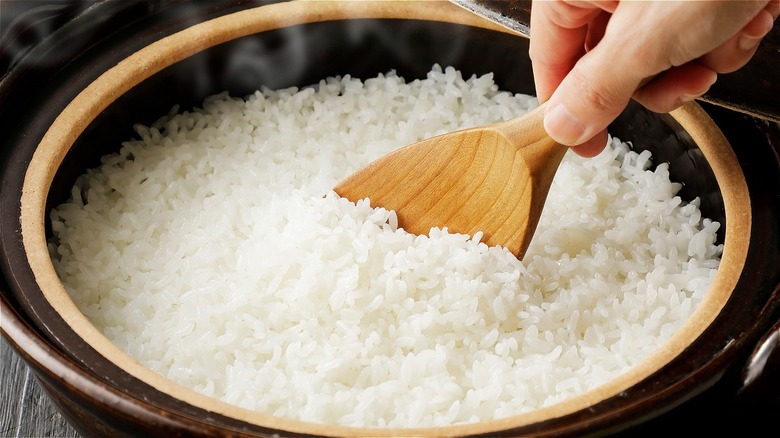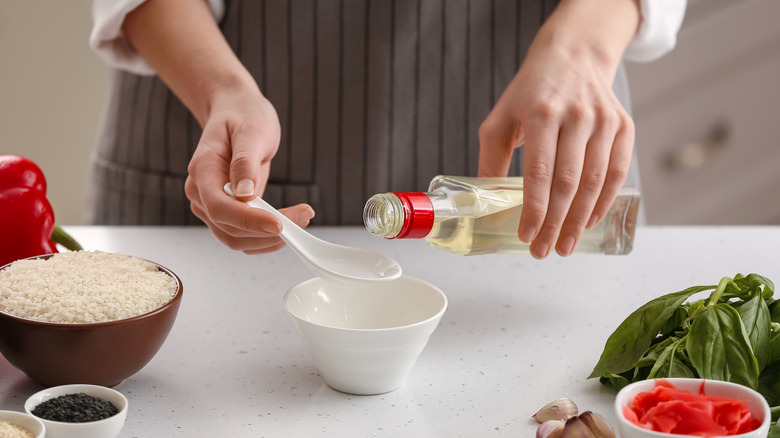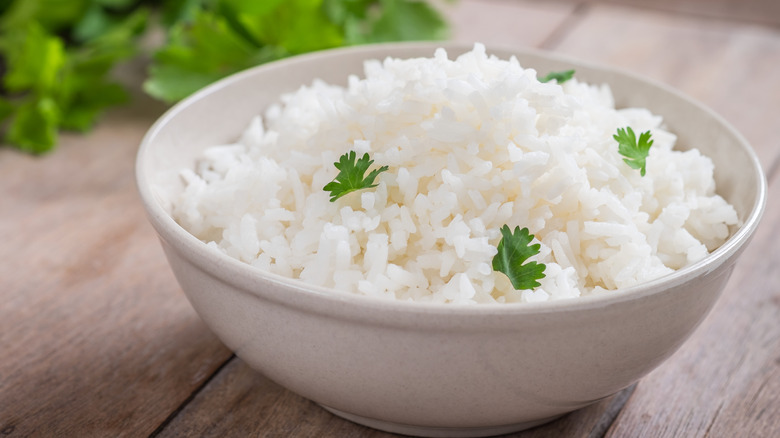Why You Should Be Cooking Your Rice With Some Vinegar
Rice comes in 40,000 varieties, including long-grain white, short-grain white, brown, wild, jasmine, black, and glutinous or sticky rice used for sushi. The proper cooking method is a matter of preference and tradition, as is how much water or salt to use when boiling, steaming, or using a rice cooker. Some home cooks insist that all rice varieties be rinsed before cooking to remove the extra starch and create fluffier rice while others argue only long-grain white rice needs to be rinsed.
Each culture has a preferred variety and cooking method for rice. Americans prefer Carolina Gold's long-grain white or brown rice for popular dishes like a dirty cajun rice recipe. Indian and Pakistani cuisine favors aromatic basmati rice, and Spanish cuisine prefers Bomba or Valencia short-grain rice (named after the Spanish region it is grown in) used in paella. Italian cuisine enjoys short-grain arborio rice used in risotto.
Replacing water with different liquids — like coconut milk or chicken stock — changes the flavor, adding another dimension to the grain; other types of liquids can be used to change the texture without affecting the flavor. Though plain tap water will do the trick, for rice that is light and fluffy you should consider adding some vinegar to the pot.
Make fluffier rice
The naturally gluten-free grain is as easy to make as it is to mess up. Within 15 minutes, rice can turn into a gloppy, gummy, or burnt mess without the proper technique. And if your rice is never quite as fluffy as you'd like, adding white vinegar to long-grain white rice is just the tip you need. The acid acts like a rinsing agent, removing extra starch from the grain's exterior and preventing the rice from congealing in the pot.
If you were concerned about the flavor, rest assured the amount of vinegar you will be adding won't be noticeable. For every cup of rice, one teaspoon of white vinegar and two cups of liquid should be added to a medium saucepan. Unless specified, the traditional ratio of water to rice is two parts water to one part rice, although rice cookers often require less liquid. Cover the white rice and lower the heat when the water boils. Once the water has been absorbed, fluff the individual grains removing any clumps, using a fork, and adjust the seasoning with Kosher salt, fresh herbs, or another liquid like citrus or soy sauce to taste. Although less popular, rice can also be made like pasta. Boil rice in lots of water and strain the grain when it's done to your liking.
This is far from the only benefit of using vinegar. In fact, some further facts might increase your chance of using it.
Vinegar poses many health benefits
Along with preventing cooked rice from sticking together or to the pot, adding vinegar to rice has many health benefits. According to a study by Self Decode, meals including vinegar, especially ones with a high glycemic index such as rice, cause less of a blood sugar spike after consumption. As explained to Levels by Ohio dietician Ashley Koff, RD, vinegar works to "block or subdue the capabilities of the enzymes that break down the carb [curbs the] rapid absorption of the carb as glucose." It also improves insulin sensitivity, potentially making it an effective choice for slowing the onset of diabetes.
Furthermore, vinegar can be used to kill harmful bacteria before eating foods of questionable origin. Though the evidence for the claims is not conclusive, there's a chance vinegar's low-calorie count can aid in weight loss and increase heart health.
Instead of assuming every bottle of vinegar is made the same, Harvard recommends checking the nutrition facts. Sometimes, sugar can sneak its way into vinegar depending on what it's mixed with. Vinegar itself doesn't come without risks either. When adding it to rice, be careful not to pour too much. If you do, it can wreak havoc on your esophagus, cause acid reflux, and upset your stomach.
Other ways to pump up your rice
If you don't have vinegar on hand, there are a few other ways to liven up your rice. If you want to make it fluffier, you can use a fork or other utensil to fluff it up yourself before serving it. This will also separate clumps of rice. To prevent it from becoming mushy until serving time, simply set a towel over the rice to catch condensation as it escapes from the hot pan.
There are also other ways to prevent rice from sticking together. A strainer is an essential tool to stop clumping. By running water through a rice-filled, fine strainer, much of the starch will be washed off. Besides vinegar, talcum can be added to rice to keep it separated.
Sometimes, the state of your finished rice product is explained by simple human error. One mistake everyone makes when cooking rice? Not rinsing it, or not using cold water when you do. There's also a chance you are cranking the heat too high as you impatiently wait for dinner to be ready. This can result in different inner and outer textures and perhaps even burning. Though it also takes a certain degree of patience, letting rice sit can't be skipped, no matter how badly you wish to serve it. Rice should rest for around 10 minutes undisturbed before it's ready to serve.



